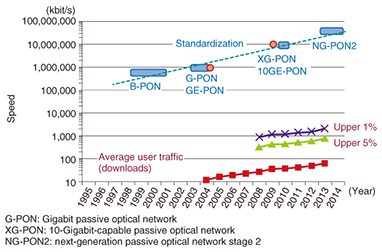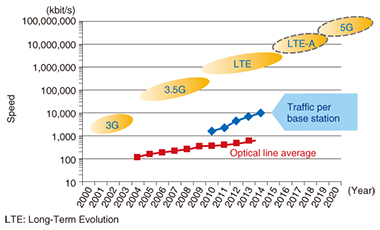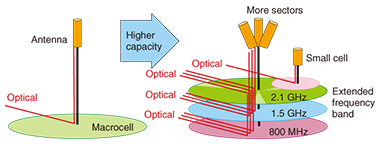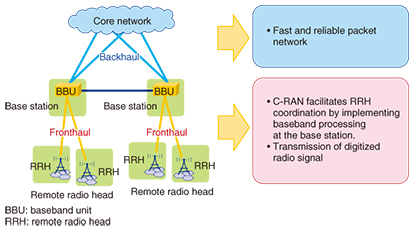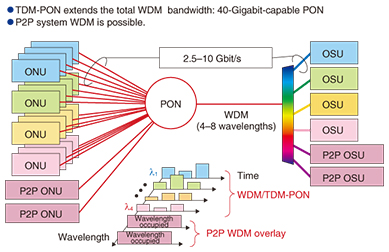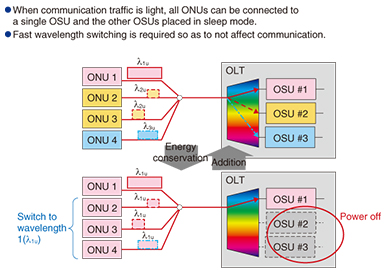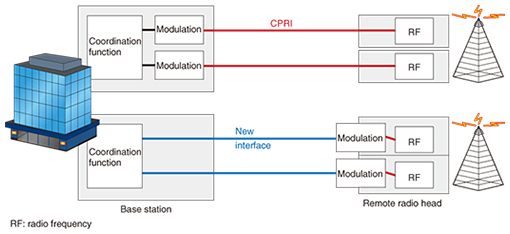 |
|||||||||||||||||||||
|
|
|||||||||||||||||||||
|
Feature Articles: NTT Tsukuba Forum 2014 Workshop Lectures Vol. 13, No. 3, pp. 52–57, Mar. 2015. https://doi.org/10.53829/ntr201503fa9  Future Optical Access Technologies for Flexible Service DeploymentกกAbstractThe direction of technical development in optical access systems has mainly been towards achieving stable Internet access at higher speeds. However, we now recognize that technology for higher speeds alone is not enough to keep up with a changing market. Flexible use of resources is considered to be a requirement for the next generation of optical access. This article presents an overview of this problem and other upcoming challenges and describes examples of technology that NTT Access Network Service Systems Laboratories is working on in order to come up with solutions. These Feature Articles are based on presentations made at the Tsukuba Forum 2014 Workshop that was held on October 17, 2014. Keywords: access system, WDM/TDM-PON, mobile 1. Next-generation optical access challengesOptical access systems have mainly been used for broadband Internet access. Fiber-to-the-home (FTTH) services began with the 50-Mbit/s passive optical network (PON), which was followed by B-PON (broadband-PON). The current Gigabit Ethernet (GE)-PON system can provide services at up to 1 Gbit/s. Statistics provided by the Ministry of Internal Affairs and Communications show that Internet traffic in Japan moves at approximately 2.9 Tbit/s over fixed lines (May 2014) and at approximately 620 Gbit/s over the mobile network (June 2014) [1, 2]. These figures represent an annual rate of increase of 30% for the fixed network and 50% for the mobile network. We can see that although traffic is steadily increasing, the increase in the number of optical lines has begun to taper off. In view of this situation, what is required of optical access in the future? The respective circumstances for fixed-line and mobile communications are reviewed in this section. 1.1 Fixed linesFrom the change in traffic volume per fixed-line user over time (Fig. 1) [1, 3, 4] we can see that the traffic per user is only about 100 kbit/s, which is only about 10 seconds per day for a 1-Gbit/s line. Even for heavy users in the top 1%, the average speed is only several megabits per second, which is still far below the available access speeds. We can also see that the increasing trend in traffic volume is exceeded by the progress in technology for higher speeds. We should note here that this discussion concerns the average values, and so does not cover phenomena that occur rarely. On the scale at which a certain number of users share bandwidth in a single access system, such as PON, we cannot necessarily expect a statistical multiplexing effect. For this reason, an important point is whether or not services can be provided without any problem when rarely occurring phenomena are taken into account. An IP (Internet protocol) video service, for example, must be capable of providing the service even when all subscribers are using the service to the maximum extent when the total content bandwidth and number of simultaneously available channels for all users is within the total access bandwidth. In other words, that requires the access system to have a higher capacity than when bandwidth is considered in terms of average usage levels, which results in wasted resources. In the Hikari Collaboration Model [5], NTT’s new business model in which a particular form of use or bandwidth is secured for partner providers, efficient resource allocation will be important to provide economical optical access.
1.2 Optical lines for mobile communicationMobile communication base stations are connected to the network by optical lines, and the traffic on those lines is increasing because of the mutual amplifying effect of an increasing number of users and increasing communication volume per user. Optical line speeds are currently higher than wireless speeds, so the radio link is the bandwidth bottleneck. The trend in traffic volume per base station, obtained by dividing the amount of mobile traffic by the number of base stations, is shown in Fig. 2 [2–4, 6]. Just as with fixed lines, there is a sufficient margin in optical line speed. In contrast, speeds higher than wireless speeds are required for optical lines. Implementation of wireless speeds in excess of 10 Gbit/s is being studied for the future fifth-generation (5G) mobile communication, and speeds above the 1-Gbit/s rate that is currently provided by optical lines will be required.
The direction of mobile communication technology as it progresses will be toward meeting the requirements for greater use of optical access as well as achieving higher optical line speeds. Increases in mobile capacity will come from the use of smaller cells, higher cell density, expansion of the radio frequency band, and other such factors, in addition to higher wireless transmission speeds. That will require more optical lines (Fig. 3).
There are also issues that are specific to mobile communication. Mobile networks are divided into the backhaul, which connects base stations to the core network, and the fronthaul, which connects base stations to remote radio heads (RRHs) (Fig. 4). The backhaul network is a high speed, highly reliable packet network whose speed depends on the traffic volume. The fronthaul network, on the other hand, uses a C-RAN (centralized radio access network) configuration, which facilitates coordination processing for multiple RRH towers that have overlapping signal areas. In that configuration, baseband processing and other processing is done at the base station, and only the high-frequency processing is done at the RRH tower, so the fronthaul part uses a CPRI (Common Public Radio Interface) signal, which is a digitized radio waveform. CPRI uses a fixed rate whether or not users are communicating, and requires a speed of about 16 times that of wireless transmission. With 150-Mbit/s LTE (Long-Term Evolution), for example, an optical transmission speed of 2.4 Gbit/s is required. If adopted in the present form for 5G mobile communication, the system would require an optical excess capacity of 160 Gbit/s per RRH tower, which is impractical.
Thus, the challenges for future high-speed mobile communication mainly concern the fronthaul system, specifically, the commitment of resources whether or not users are using the system, and the very large required bandwidth. 2. Implementing the next-generation optical accessWe believe that the past trend of simply increasing speed is limited as a solution to the problems outlined above. We present here technology that NTT Access Network Service Systems Laboratories is working on that represents a different approach. 2.1 WDM/TDM-PONWDM/TDM-PON uses wavelength division multiplexing (WDM) to superimpose multiple time division multiplexing (TDM) PON on a single fiber (Fig. 5). Currently, the International Telecommunication Union Telecommunication Standardization Sector (ITU-T) is moving forward with standardization of 10-Gbit/s PON as the NG-PON2 (next-generation passive optical network stage 2) [7]. This is a 40-Gbit/s PON that multiplexes four typical 10-Gbit/s PON systems. This format also allows WDM for point-to-point (P2P) systems, which will be advantageous for mobile communication applications.
Although multiplexing four 10-Gbit/s PON systems on a single fiber quadruples the bandwidth, this WDM/TDM-PON is not simply a 40-Gigabit-capable PON system. The WDM technique has been used to achieve target communication speeds that are relatively low in the early stage of standardization, for which further speed improvements have been difficult. However, that was a transitional technology, and technical advances mean that it has since been replaced with high-speed serial communication. In WDM/TDM-PON, WDM is not simply a technique for achieving higher speeds. The multiplexing of four 10-Gbit/s signals differs from a 40-Gbit/s serial signal in that the multiplexing provides flexibility in the use of wavelengths. The advantages of wavelength flexibility are described below. The wavelength flexibility in a WDM/TDM-PON system is implemented by the ability to dynamically set the wavelength that is used by the optical network unit (ONU) for communication. That eliminates the need to provide an ONU for each wavelength, as shown in Fig. 5, which is an advantage in respect to the ONU management. The dynamic setting of the ONU wavelength also enables flexible bandwidth allocation and increases reliability. The improvement in reliability comes from being able to continue communication with a different optical subscriber unit (OSU) when an OSU fails during communication by switching the ONU wavelength [8]. When traffic volume is low, energy can be conserved by connecting all of the ONUs to a single OSU and placing all of the other OSUs into sleep mode (Fig. 6). Conversely, if it is known in advance that traffic will be low, service can be started on a single OSU with more OSUs added successively as needed to accommodate increasing traffic. It is also possible to dynamically change connections between ONUs and OSUs, making it possible to switch to the appropriate OSU at any time in consideration of the user ONU resources needed to ensure bandwidth. The WDM technique can thus be used to avoid the current problem of configuring facilities for maximum capacity regardless of the amount of traffic.
In addition to moving forward with R&D on WDM/TDM-PON based on that approach, NTT Access Network Service Systems Laboratories is also using these results to contribute to standardization of NG-PON2 in ITU-T. 2.2 Compression technology and interface redefinition technologyFor the mobile network, we are mainly working on developing technology to reduce fronthaul speeds. Here, we describe compression technology and interface redefinition technology for that purpose. As mentioned earlier, the fronthaul system currently transmits radio waveform information, so optical transmission at a fixed speed is required, regardless of user traffic volume. NTT Access Network Service Systems Laboratories has developed compression technology for greatly reducing the radio waveform sample data by exchanging information on the user communication situation between the radio base station and the optical access system [9]. Also, processing for coordination of the RRHs is performed at the base station in the current fronthaul configuration, and only the high-frequency processing is performed at the RRH. NTT Access Network Service Systems Laboratories has shown that a new interface definition that reduces fronthaul bandwidth is made possible by revising that functional distribution and assigning appropriate functions to the RRHs to implement inter-RRH coordination (Fig. 7) [10].
We believe these technologies can be applied to create a mechanism in which bandwidth is allocated flexibly according to traffic level and only during communication to replace the conventional wasteful reserving of fixed optical access bandwidth. 3. Future developmentThe next generation of optical access systems is facing problems that the conventional approach of simply increasing speed cannot solve. Various research programs are underway based on the approach of allocating the required resources when required, such as that described here. In the future, it will probably be possible to shift bandwidth flexibly from the home to the business district during business hours and from the mobile network to the home during evening meal times. We are working on achieving such an efficient communication society. References
Author profileCareer highlightsExecutive Manager, NTT Access Network Service Systems Laboratories. Akihiro Otaka received the B.S. and M.S. in physics from the University of Tokyo in 1989 and 1991, respectively. He joined NTT in 1991 and engaged in developing optical lithography technologies for LSI fabrication. In 1998, he began working on the development and standardization of optical access systems such as Gigabit and 10 Gigabit EPON. From 2010 to 2014, he was with NTT EAST R&D Center, where he worked on optical access, wireless access, and wireless home networks. He joined NTT Access Network Service Systems Laboratories in 2014. |
|||||||||||||||||||||









